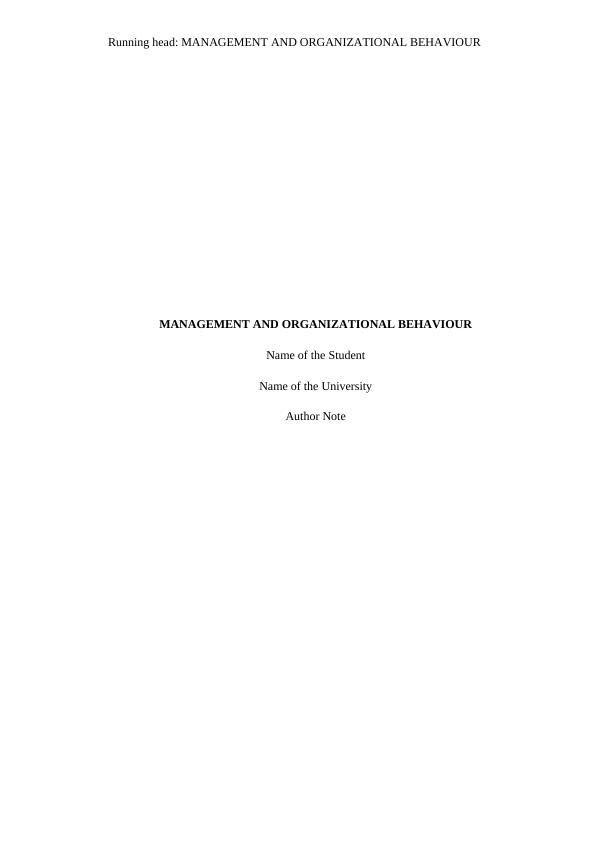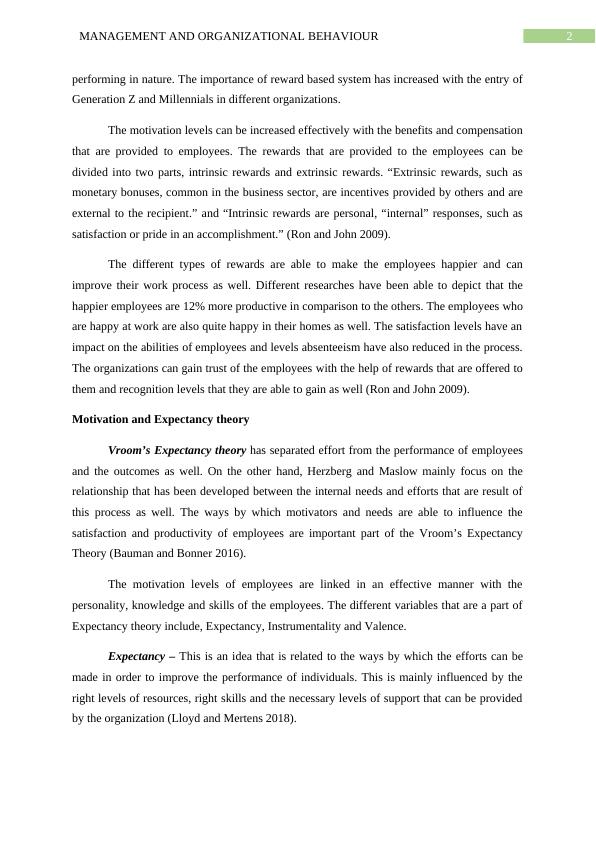Motivation and Organizational Behaviour
Added on 2023-01-19
6 Pages1880 Words82 Views
Running head: MANAGEMENT AND ORGANIZATIONAL BEHAVIOUR
MANAGEMENT AND ORGANIZATIONAL BEHAVIOUR
Name of the Student
Name of the University
Author Note
MANAGEMENT AND ORGANIZATIONAL BEHAVIOUR
Name of the Student
Name of the University
Author Note

1MANAGEMENT AND ORGANIZATIONAL BEHAVIOUR
Introduction
As discussed by Lăzăroiu (2015), motivation is considered to be a major reason that is
related to the actions, goals and willingness of people to perform their jobs and to achieve the
goals as well. The needs of the consumers are mainly based on the lifestyle, society and
culture of the organization. The direction that is provided to individuals based on their
behaviour is related to proper motivation levels. The motivation of an individual can be
effectively influenced by different events and the other individuals as well.
According to (Bauman and Bonner 2016), Vroom’s Expectancy Theory of Motivation
is based on the behaviour that is related to the conscious choices between different
alternatives that are provided to the individuals. The main purpose related to choice of
alternatives is based on providing maximum levels of pleasure and minimum levels of pain.
According to Vroom, the performance of employees is related to different factors like, skills,
personality, experience, knowledge and the abilities. The performance and efforts are related
to the motivation levels of a person. “Expectancy theory perspective may be a useful tool for
the study and understanding of coordination.” (Bauman and Bonner 2016).
Motivation
As opined by Yu-Wei, Ping-Yu and Zeng-Yuan (2015), motivation is considered to
be a major reason behind the behaviour levels of individuals and their work process within
the organization as well. The instructional practice is helpful for the ways by which
motivation levels can be achieved in an effective manner. Positive and negative levels of
motivation are mainly based on the instructional practice that is followed in the organizations.
The motivational resources that are provided to the individuals need to be used efficiently in
order to achieve the goals and objectives that are provided to them. In case of academics the
motivational levels of students can be increased if they are able to complete a task within
provided time frame (Lăzăroiu 2015).
As discussed by Ron and John (2009), rewards are able to play a major role in
increasing the levels of motivation in the industry. The productivity levels of employees can
be increased with the help of effective rewards that are offered to them. The recognition and
rewards based programs are able to acknowledge the contributions that are provided to them
with respect to the goals of the organization. The levels of appreciation that are depicted by
the organization are able to play a major role in development of a workplace that is high
Introduction
As discussed by Lăzăroiu (2015), motivation is considered to be a major reason that is
related to the actions, goals and willingness of people to perform their jobs and to achieve the
goals as well. The needs of the consumers are mainly based on the lifestyle, society and
culture of the organization. The direction that is provided to individuals based on their
behaviour is related to proper motivation levels. The motivation of an individual can be
effectively influenced by different events and the other individuals as well.
According to (Bauman and Bonner 2016), Vroom’s Expectancy Theory of Motivation
is based on the behaviour that is related to the conscious choices between different
alternatives that are provided to the individuals. The main purpose related to choice of
alternatives is based on providing maximum levels of pleasure and minimum levels of pain.
According to Vroom, the performance of employees is related to different factors like, skills,
personality, experience, knowledge and the abilities. The performance and efforts are related
to the motivation levels of a person. “Expectancy theory perspective may be a useful tool for
the study and understanding of coordination.” (Bauman and Bonner 2016).
Motivation
As opined by Yu-Wei, Ping-Yu and Zeng-Yuan (2015), motivation is considered to
be a major reason behind the behaviour levels of individuals and their work process within
the organization as well. The instructional practice is helpful for the ways by which
motivation levels can be achieved in an effective manner. Positive and negative levels of
motivation are mainly based on the instructional practice that is followed in the organizations.
The motivational resources that are provided to the individuals need to be used efficiently in
order to achieve the goals and objectives that are provided to them. In case of academics the
motivational levels of students can be increased if they are able to complete a task within
provided time frame (Lăzăroiu 2015).
As discussed by Ron and John (2009), rewards are able to play a major role in
increasing the levels of motivation in the industry. The productivity levels of employees can
be increased with the help of effective rewards that are offered to them. The recognition and
rewards based programs are able to acknowledge the contributions that are provided to them
with respect to the goals of the organization. The levels of appreciation that are depicted by
the organization are able to play a major role in development of a workplace that is high

2MANAGEMENT AND ORGANIZATIONAL BEHAVIOUR
performing in nature. The importance of reward based system has increased with the entry of
Generation Z and Millennials in different organizations.
The motivation levels can be increased effectively with the benefits and compensation
that are provided to employees. The rewards that are provided to the employees can be
divided into two parts, intrinsic rewards and extrinsic rewards. “Extrinsic rewards, such as
monetary bonuses, common in the business sector, are incentives provided by others and are
external to the recipient.” and “Intrinsic rewards are personal, “internal” responses, such as
satisfaction or pride in an accomplishment.” (Ron and John 2009).
The different types of rewards are able to make the employees happier and can
improve their work process as well. Different researches have been able to depict that the
happier employees are 12% more productive in comparison to the others. The employees who
are happy at work are also quite happy in their homes as well. The satisfaction levels have an
impact on the abilities of employees and levels absenteeism have also reduced in the process.
The organizations can gain trust of the employees with the help of rewards that are offered to
them and recognition levels that they are able to gain as well (Ron and John 2009).
Motivation and Expectancy theory
Vroom’s Expectancy theory has separated effort from the performance of employees
and the outcomes as well. On the other hand, Herzberg and Maslow mainly focus on the
relationship that has been developed between the internal needs and efforts that are result of
this process as well. The ways by which motivators and needs are able to influence the
satisfaction and productivity of employees are important part of the Vroom’s Expectancy
Theory (Bauman and Bonner 2016).
The motivation levels of employees are linked in an effective manner with the
personality, knowledge and skills of the employees. The different variables that are a part of
Expectancy theory include, Expectancy, Instrumentality and Valence.
Expectancy – This is an idea that is related to the ways by which the efforts can be
made in order to improve the performance of individuals. This is mainly influenced by the
right levels of resources, right skills and the necessary levels of support that can be provided
by the organization (Lloyd and Mertens 2018).
performing in nature. The importance of reward based system has increased with the entry of
Generation Z and Millennials in different organizations.
The motivation levels can be increased effectively with the benefits and compensation
that are provided to employees. The rewards that are provided to the employees can be
divided into two parts, intrinsic rewards and extrinsic rewards. “Extrinsic rewards, such as
monetary bonuses, common in the business sector, are incentives provided by others and are
external to the recipient.” and “Intrinsic rewards are personal, “internal” responses, such as
satisfaction or pride in an accomplishment.” (Ron and John 2009).
The different types of rewards are able to make the employees happier and can
improve their work process as well. Different researches have been able to depict that the
happier employees are 12% more productive in comparison to the others. The employees who
are happy at work are also quite happy in their homes as well. The satisfaction levels have an
impact on the abilities of employees and levels absenteeism have also reduced in the process.
The organizations can gain trust of the employees with the help of rewards that are offered to
them and recognition levels that they are able to gain as well (Ron and John 2009).
Motivation and Expectancy theory
Vroom’s Expectancy theory has separated effort from the performance of employees
and the outcomes as well. On the other hand, Herzberg and Maslow mainly focus on the
relationship that has been developed between the internal needs and efforts that are result of
this process as well. The ways by which motivators and needs are able to influence the
satisfaction and productivity of employees are important part of the Vroom’s Expectancy
Theory (Bauman and Bonner 2016).
The motivation levels of employees are linked in an effective manner with the
personality, knowledge and skills of the employees. The different variables that are a part of
Expectancy theory include, Expectancy, Instrumentality and Valence.
Expectancy – This is an idea that is related to the ways by which the efforts can be
made in order to improve the performance of individuals. This is mainly influenced by the
right levels of resources, right skills and the necessary levels of support that can be provided
by the organization (Lloyd and Mertens 2018).

End of preview
Want to access all the pages? Upload your documents or become a member.
Related Documents
Effective Reward Communication within Organizationslg...
|11
|2756
|83
Organizational Behavior Assignment 2022lg...
|14
|2809
|31
Expectancy Theory and Goal Setting Theory: A Critical Analysislg...
|9
|2368
|475
Theory of Organisational Behaviourlg...
|6
|802
|35
Motivation in Workplace.lg...
|11
|351
|56
Employee Motivation: Theories and Application in the Workplacelg...
|9
|2224
|125
